C++数据结构图(邻接矩阵和邻接表、图的遍历、两种最小生成树、三种最短路径)
树是特殊的图,对于图来说,树是一种无环的连通图。对于树来说,我们通常使用树的节点来存储数据,主要关系树的节点;但对于图来说,我们通常**研究节点与节点(边)的连接关系**。
图
1. 图的基本概念
树是特殊的图,对于图来说,树是一种无环的连通图。对于树来说,我们通常使用树的节点来存储数据,主要关系树的节点;但对于图来说,我们通常研究节点与节点(边)的连接关系。
1.1 完全图
在 n n n 个顶点的无向图中,若有 n ( n − 1 ) 2 \frac{n(n-1)}{2} 2n(n−1) 条边,即任意两个顶点有且只有一条边,则此图为完全图。
在 n n n 个顶点的有向图中,若有 n ( n − 1 ) {n(n-1)} n(n−1) 条边,即任意两个顶点有且仅有方向相反的边,则此图为有向完全图。

1.2 邻接顶点
在无向图中,若 ( u , v ) (u,v) (u,v) 是 E ( G ) \rm E(G) E(G) 中的一条边,则称 u u u 和 v v v 互为邻接顶点,并称边 ( u , v ) (u,v) (u,v) 依附于顶点 u u u 和 v v v 。
在有向图中,若 < u , v > \text <u,v\text> <u,v> 是 E ( G ) \rm E(G) E(G) 中的一条边,则称顶点 u u u 邻接到 v v v ,顶点 v v v 邻接自顶点 u u u ,并称边 < u , v > \text <u,v\text> <u,v> 与顶点 u u u 和 v v v 相关联。
1.3 顶点的度
顶点的度是指与它相关联的边的个数,顶点的度等于该顶点的入度和出度之和。对于有向图,入度是指以顶点为终点的有向边的个数,出度是指以顶点为起点的有向边的个数( d e v ( v ) = i n d e v ( v ) + o u t d e v ( v ) \rm dev(v) = indev(v) + outdev(v) dev(v)=indev(v)+outdev(v));对于无向图,入度与出度相等( d e v ( v ) = i n d e v ( v ) = o u t d e v ( v ) \rm dev(v) = indev(v) = outdev(v) dev(v)=indev(v)=outdev(v))。
1.4 路径
在图 G = ( V , E ) \rm G = (V,E) G=(V,E) 中,若从顶点 V i V_i Vi 出发有一组边使其可以到达顶点 V j V_j Vj ,则称顶点 V i V_i Vi 到顶点 V j V_j Vj 的顶点序列,为顶点 V i V_i Vi 到顶点 V j V_j Vj 的路径。
对于不带权的图,一条路径的长度是指该路径上边的条数;对于带权图,一条路径的长度是指该路径上各个边权值的总和。
若一条路径上各顶点 V 1 , V 2 , V 3 , . . . , V m V_1,V_2,V_3,...,V_m V1,V2,V3,...,Vm 均不重复,则这样的路径称为简单路径;若路径上第一个顶点 V 1 V_1 V1 与最后一个顶点 V m V_m Vm 重合,则这样的路径称为回路或环。
1.5 连通图
在无向图中,若从顶点 V 1 V_1 V1 到顶点 V 2 V_2 V2 有路径,就称顶点 V 1 V_1 V1 与顶点 V 2 V_2 V2 是连通的。如果图中任意一对顶点都是连通的,则称此图为连通图。
在有向图中,若每一对顶点 V i V_i Vi 和 V j V_j Vj 之间都存在一条从 $V_i $ 到 V j V_j Vj 的路径,也存在一条从 V j V_j Vj 到 V i V_i Vi 的路径,则称此图是强连通图。
2. 图的存储结构
图的存储方式主要有两种,邻接矩阵和邻接表。
2.1 邻接矩阵
邻接矩阵使用一个二维数组来表示图中各个节点之间的连接关系。对于一个包含 n n n 个节点的图,邻接矩阵是一个 $n \times n $ 的矩阵,其中矩阵中的每个元素表示节点之间的边(可以是权重,也可以表示是否存在边)。

如果是带权图,矩阵内的值为权值。顶点与自身的权值为 0 ,如果两个顶点不通,它们的权值为 ∞ \infty ∞。
2.1.1 邻接矩阵的优缺点
优点:
- 实现简单,适合稠密图(边数接近于节点数平方的情况)。
- 判断两个节点是否相邻非常高效,只需 O ( 1 ) O(1) O(1) 时间复杂度。
缺点:
- 空间复杂度较高,对于稀疏图来说会浪费大量内存。
2.1.2 代码实现
V 为图中数据的类型,W 为权值的类型(一般为 int)。
#include <vector>
#include <map>
#include <iostream>
using namespace std;
//邻接矩阵
template<class V,class W,W MAX_W = INT_MAX, bool Direction = false>
class Graph
{
public:
typedef Graph<V, W, MAX_W, Direction> Self;
Graph() = default;
Graph(const V* vertexs, size_t n)
{
_vertexs.reserve(n);
for (size_t i = 0; i < n; i++)
{
_vertexs.push_back(vertexs[i]);
_vIndexMap[vertexs[i]] = i;
}
//用MAX_W表示无穷大
_matrix.resize(n, vector<W>(n, MAX_W));
}
size_t GetVertexIndex(const V& v)
{
auto ret = _vIndexMap.find(v);
if (ret != _vIndexMap.end())
{
return ret->second;
}
else
{
throw invalid_argument("不存在的顶点");
return -1;
}
}
void AddEdge(const V& src, const V& dest, const W& w)
{
size_t srci = GetVertexIndex(src);
size_t desti = GetVertexIndex(dest);
_matrix[srci][desti] = w;
if (Direction == false)
{
_matrix[desti][srci] = w;
}
}
void PrintMatrix() const
{
cout << "邻接矩阵:" << endl;
for (const auto& row : _matrix)
{
for (const auto& weight : row)
{
if (weight == MAX_W)
cout << "∞\t"; // 用 "∞" 表示无穷大
else
cout << weight << "\t";
}
cout << endl;
}
}
private:
map<V, size_t> _vIndexMap;//快速查找顶点在邻接矩阵中的索引
vector<V> _vertexs; //顶点集合
vector<vector<W>> _matrix; //边的邻接矩阵
};
int main()
{
Graph<char, int, INT_MAX, true> g("0123", 4);
g.AddEdge('0', '1', 1);
g.AddEdge('0', '3', 4);
g.AddEdge('1', '3', 2);
g.AddEdge('1', '2', 9);
g.AddEdge('2', '3', 8);
g.AddEdge('2', '1', 5);
g.AddEdge('2', '0', 3);
g.AddEdge('3', '2', 6);
g.PrintMatrix();
}
2.2 邻接表
邻接表则为图中的每个节点维护一个链表或数组,使用链表表示边的关系。


2.2.1 邻接表的优缺点
优点:
- 空间效率高,特别适合稀疏图。
- 存储结构灵活,可以方便地添加或删除边。
缺点:
- 判断两个节点是否直接相邻可能需要遍历链表,最坏情况时间复杂度较高。
2.2.2 代码实现
代码实现中,邻接表节点的插入使用头插提高插入效率。有向图只实现了记录每个顶点的出边,实现入边需要增加一个邻接表。V 为图中数据的类型,W 为权值的类型(一般为 int)。
#include <vector>
#include <map>
#include <iostream>
#include <string>
using namespace std;
//邻接表
template<class W>
class LinkEdge
{
public:
int _srcIndex;
int _destIndex;
W _w;
LinkEdge<W>* _next;
LinkEdge(const W& w):_srcIndex(-1),_destIndex(-1),_w(w),_next(nullptr)
{}
};
template<class V, class W, bool Direction = false>
class Graph
{
public:
typedef LinkEdge<W> Edge;
Graph(const V* vertex,size_t n)
{
for (size_t i = 0; i < n; i++)
{
_vertexs.push_back(vertex[i]);
_vIndexMap[vertex[i]] = i;
}
_tables.resize(n, nullptr);
}
size_t GetVertexIndex(const V& v)
{
auto ret = _vIndexMap.find(v);
if (ret != _vIndexMap.end())
{
return ret->second;
}
else
{
throw invalid_argument("不存在的顶点");
return -1;
}
}
void AddEdge(const V& src, const V& dest, const W& w)
{
size_t srcIndex = GetVertexIndex(src);
size_t destIndex = GetVertexIndex(dest);
Edge* edge = new Edge(w);
edge->_srcIndex = srcIndex;
edge->_destIndex = destIndex;
//头插
edge->_next = _tables[srcIndex];
_tables[srcIndex] = edge;
if (Direction == false)
{
Edge* dest_edge = new Edge(w);
dest_edge->_srcIndex = destIndex;
dest_edge->_destIndex = srcIndex;
dest_edge->_next = _tables[destIndex];
_tables[destIndex] = dest_edge;
}
}
void PrintGraph() const
{
for (size_t i = 0; i < _tables.size(); i++)
{
cout << _vertexs[i] << " -> ";
Edge* p = _tables[i];
while (p != nullptr)
{
cout << "[" << _vertexs[p->_destIndex] << ", " << p->_w << "] ";
p = p->_next;
}
cout << endl;
}
}
private:
map<string, int> _vIndexMap;//快速查找顶点在邻接矩阵中的索引
vector<V> _vertexs; //顶点集合
vector<Edge*> _tables; //邻接表
};
int main()
{
string a[] = { "张三", "李四", "王五", "赵六" };
Graph<string, int> g1(a, 4);
g1.AddEdge("张三", "李四", 100);
g1.AddEdge("张三", "王五", 200);
g1.AddEdge("王五", "赵六", 30);
g1.PrintGraph();
}
3. 图的遍历
图的遍历分为深度优先遍历(DFS)和广度优先遍历(BFS)。两者的区别是,深度优先遍历会沿着一条路径走到头,再回过来遍历没有经过的顶点;广度优先遍历会先遍历与一个顶点连接的所有顶点,再深入其他顶点遍历没有遍历过的顶点。
需要注意的是,无论是深度优先遍历还是广度优先遍历,只有连通图才能一次遍历到所有的顶点。所以,也可以通过深度优先遍历和广度优先遍历找出哪些顶点不连通。
3.1 深度优先遍历(DFS)
深度优先搜索通过不断向前探索,直到无法继续为止,然后回溯寻找其他路径。深度优先的遍历结果不是唯一的,当一个顶点连接多个顶点时,道路的分叉会导致遍历出现不同的结果:
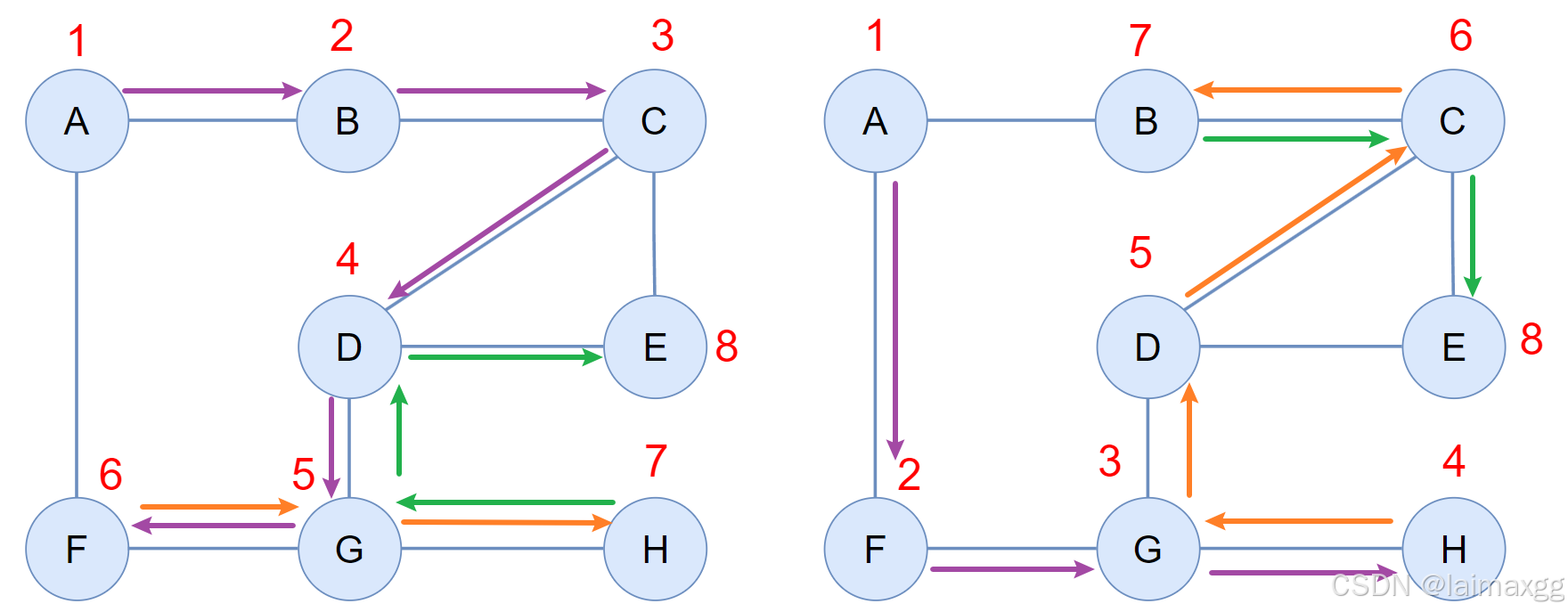
3.1.1 代码实现
邻接矩阵实现:
//...
void _DFS(const V& v, vector<bool>& isvisted)
{
cout << v << " ";
int index = GetVertexIndex(v);
for (int i = 0; i < _vertexs.size(); i++)
{
if (_matrix[index][i]!= MAX_W && !isvisted[i])
{
isvisted[i] = true;
_DFS(_vertexs[i],isvisted);
}
}
}
void DFS(const V& v)
{
vector<bool> isvisted(_vertexs.size(), false); //存储顶点是否已经被遍历过
int index = GetVertexIndex(v);
isvisted[index] = true;
_DFS(v, isvisted);
}
//...
int main()
{
string a[] = { "A", "B", "C", "D" ,"E","F","G","H" };
Graph<string, int> g1(a, 8);
g1.AddEdge("A", "B", 10);
g1.AddEdge("A", "F", 20);
g1.AddEdge("B", "C", 30);
g1.AddEdge("C", "D", 40);
g1.AddEdge("C", "E", 50);
g1.AddEdge("D", "E", 60);
g1.AddEdge("D", "G", 70);
g1.AddEdge("G", "H", 80);
g1.AddEdge("G", "F", 90);
g1.DFS("A");
}
邻接表实现:
//...
void _DFS(int index, vector<bool>& isvisted)
{
isvisted[index] = true;
cout << _vertexs[index] << " ";
Edge* edge = _tables[index];
while (edge)
{
if (!isvisted[edge->_destIndex])
{
_DFS(edge->_destIndex, isvisted);
}
edge = edge->_next;
}
}
void DFS(const V& v)
{
vector<bool> isvisted(_vertexs.size(), false);
int index = GetVertexIndex(v);
_DFS(index, isvisted);
}
//...
int main()
{
string a[] = { "A", "B", "C", "D" ,"E","F","G","H" };
Graph<string, int> g1(a, 8);
g1.AddEdge("A", "B", 10);
g1.AddEdge("A", "F", 20);
g1.AddEdge("B", "C", 30);
g1.AddEdge("C", "D", 40);
g1.AddEdge("C", "E", 50);
g1.AddEdge("D", "E", 60);
g1.AddEdge("D", "G", 70);
g1.AddEdge("G", "H", 80);
g1.AddEdge("G", "F", 90);
g1.DFS("A");
}
3.2 广度优先遍历(BFS)
广度优先遍历以层次方式逐步展开所有可能的邻居节点。广度优先遍历的结果不是唯一的,当一个顶点连接多个顶点时,道路的分叉会导致遍历出现不同的结果:
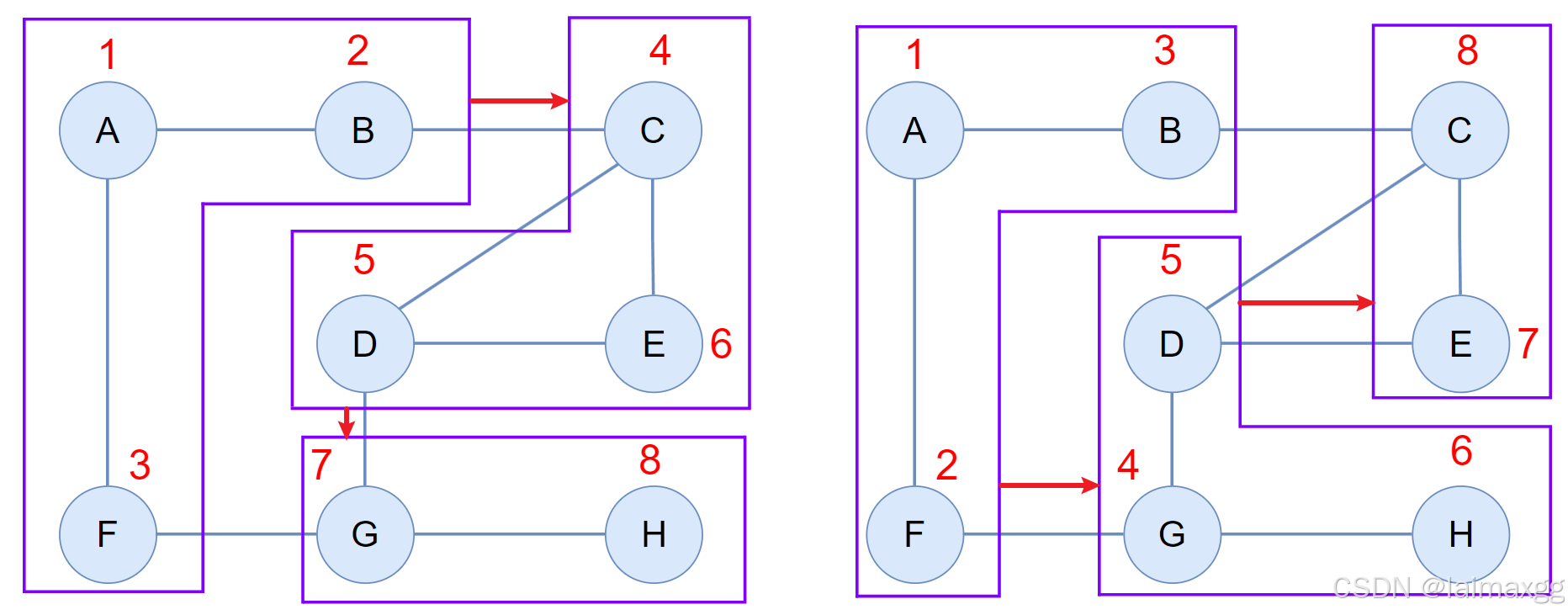
3.2.1 代码实现
邻接矩阵实现:
//....
void BFS(const V& src)
{
size_t srcindex = GetVertexIndex(src);
vector<bool> isvisted(_vertexs.size(), false); //存储顶点是否已经被遍历过
queue<int> q;
q.push(srcindex);
isvisted[srcindex] = true;
size_t d = 1;
size_t dsize = 1;
while (!q.empty())
{
dsize = q.size();
cout << "Level"<<d<<": ";
while (dsize--)
{
size_t front = q.front();
q.pop();
for (size_t i = 0; i < _vertexs.size(); i++)
{
if (isvisted[i] == false && _matrix[front][i] != MAX_W)
{
cout<< "["<<_vertexs[i] << ":" << _matrix[front][i]<<"]";
isvisted[i] = true;
q.push(i);
}
}
}
cout << endl;
d++;
}
}
//....
int main()
{
string a[] = { "A", "B", "C", "D" ,"E","F","G","H" };
Graph<string, int> g1(a, 8);
g1.AddEdge("A", "B", 10);
g1.AddEdge("A", "F", 20);
g1.AddEdge("B", "C", 30);
g1.AddEdge("C", "D", 40);
g1.AddEdge("C", "E", 50);
g1.AddEdge("D", "E", 60);
g1.AddEdge("D", "G", 70);
g1.AddEdge("G", "H", 80);
g1.AddEdge("G", "F", 90);
g1.BFS("A");
}
邻接表实现:
//...
void BFS(const V& v)
{
vector<bool> isvisted(_vertexs.size(), false); //存储顶点是否已经被遍历过
queue<int> q;
int index = GetVertexIndex(v);
q.push(index);
isvisted[index] = true;
while (!q.empty())
{
int currentIndex = q.front();
q.pop();
cout << _vertexs[currentIndex] << " ";
Edge* edge = _tables[currentIndex];
while (edge)
{
if (!isvisted[edge->_destIndex])
{
q.push(edge->_destIndex);
isvisted[edge->_destIndex] = true;
}
edge = edge->_next;
}
}
}
//...
4. 图的算法
4.1 最小生成树
对于一个无向连通图,最小生成树是包含图中所有顶点且边权和最小的树。它不仅保证了图的连通性,而且在众多可能的生成树中,所选边的权值总和是最低的。即,从生成树中删去任何一条边,生成树都不再连通;反之,增加任何一条边,都会形成一条回路。
- 特性: 若连通图由 n n n 个顶点组成,则生成树必包含 n n n 个顶点和 n − 1 n-1 n−1 条边。
构造最小生成树的算法有Kruskal算法和Prim算法,两者都是采用逐步求解的贪心策略。
4.1.1 Kruskal算法
Kruskal算法适合稀疏图的情况。
算法过程:
- 给定一个有 n n n 个顶点的连通网络 N = { V , E } \rm N=\{V,E\} N={V,E} 。
- 创建一个同样有 n n n 个顶点,但不包含边的图 G = { V , N U L L } \rm G=\{V,NULL\} G={V,NULL} 。
- 选取出 N \rm N N 中当前权值最小的边,在 G \rm G G 中连通对应的顶点。
- 重复 3 的操作,但 G \rm G G 中不能产生回路,直到所有顶点都被连通。
图示:
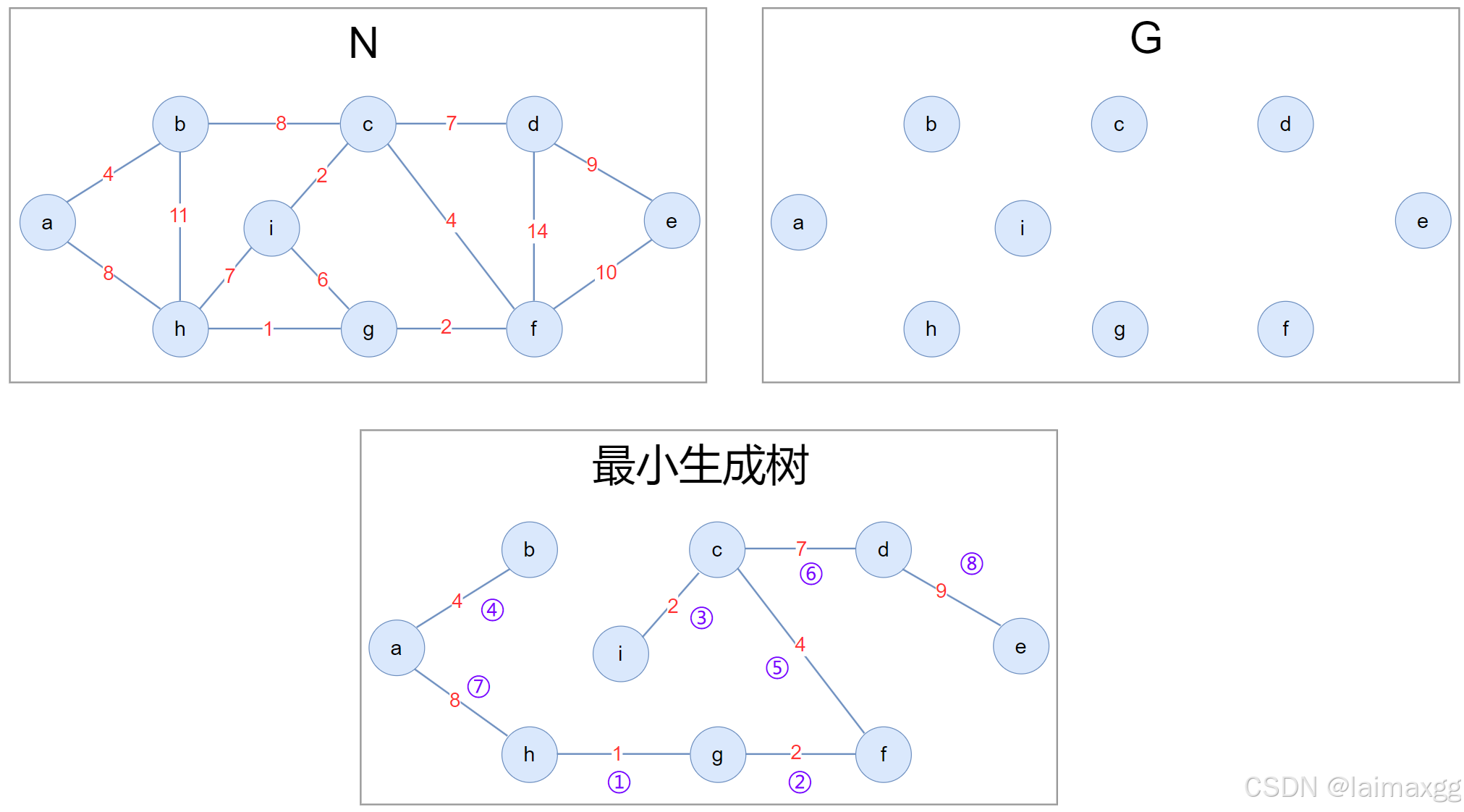
本图重绘《算法导论》中 Kruskal 算法的算法流程。
在第 ⑥ 步中,(i,g) 的边的权值更小,但连接会产生回路,于是选择权值第二小的 (c,g) 连接。
4.1.1.1 代码实现
在实现Kruskal算法时,我们需要使用到优先队列(priority_queue),优先队列的第一个元素总是队列中最大(或最小)的元素,方便我们快速地找出权值最小的边;我们还需要使用到并查集(UnionFinSet),用于查询某个顶点是否已经在生成树中,以此来避免产生回路。代码使用邻接矩阵实现:
#include <vector>
#include <map>
#include <iostream>
#include <queue>
using namespace std;
class UnionFindSet
{
public:
UnionFindSet(size_t size) :_ufs(size, -1) {}
int FindRoot(int index)
{
if (_ufs[index] < 0)
{
return index;
}
return _ufs[index] = FindRoot(_ufs[index]);
}
bool Union(int x, int y)
{
int root1 = FindRoot(x);
int root2 = FindRoot(y);
//如果两个元素本就在同一个集合返回false
if (root1 == root2)
{
return false;
}
//按秩合并,将较矮的树合并到较高的树下
//由于用负数表示秩,值越小树的高度越高
if (_ufs[root1] > _ufs[root2])
swap(root1, root2);
// 将集合 root2 合并到 root1 上
_ufs[root1] += _ufs[root2];
_ufs[root2] = root1;
return true;
}
int Count()
{
int count = 0;
for (auto it : _ufs)
{
if (it < 0)
{
count++;
}
}
return count;
}
bool InSet(int x, int y)
{
return FindRoot(x) == FindRoot(y);
}
private:
vector<int> _ufs;
};
//...
struct Edge
{
size_t _srci;
size_t _desti;
W _w;
Edge(size_t srci,size_t desti,const W& w):_srci(srci),_desti(desti),_w(w){}
bool operator>(const Edge& e) const
{
return _w > e._w;
}
};
W Kruskal(Self& minTree)
{
minTree._vertexs = _vertexs;
minTree._vIndexMap = _vIndexMap;
minTree._matrix.resize(_vertexs.size());
for (auto& it : minTree._matrix)
{
it.resize(_vertexs.size(), MAX_W);
}
priority_queue<Edge, vector<Edge>, greater<Edge>> minque;
for (size_t i = 0; i < _vertexs.size(); i++)
{
for (size_t j = 0; j < _vertexs.size(); j++)
{
if (i < j && _matrix[i][j] != MAX_W)
{
minque.push(Edge(i, j, _matrix[i][j]));//minque的第一个元素总是权值最小的边
}
}
}
int size = 0;
W totalW = W();
UnionFindSet ufs(_vertexs.size());
while (!minque.empty())
{
Edge min = minque.top();
minque.pop();
if (!ufs.InSet(min._srci, min._desti))
{
minTree.AddEdge(_vertexs[min._srci], _vertexs[min._desti], min._w);
cout << _vertexs[min._srci] << "-" << min._w << ">" << _vertexs[min._desti] << endl;
ufs.Union(min._srci, min._desti);
size++;
totalW += min._w;
}
}
if (size == _vertexs.size() - 1)
{
//如果能够构建最小生成树
return totalW;
}
else
{
return W();
}
}
//...
int main()
{
string a[] = { "a", "b", "c", "d" ,"e","f","g","h","i"};
Graph<string, int> g1(a, 9);
g1.AddEdge("a", "b", 4);
g1.AddEdge("b", "h", 11);
g1.AddEdge("a", "h", 8);
g1.AddEdge("b", "c", 8);
g1.AddEdge("c", "d", 7);
g1.AddEdge("c", "i", 2);
g1.AddEdge("d", "e", 9);
g1.AddEdge("d", "f", 14);
g1.AddEdge("e", "f", 10);
g1.AddEdge("f", "g", 2);
g1.AddEdge("f", "c", 4);
g1.AddEdge("g", "i", 6);
g1.AddEdge("g", "h", 1);
g1.AddEdge("h", "i", 7);
Graph<string, int> minTree;
cout<< g1.Kruskal(minTree);
}

4.1.2 Prim算法
Prim 算法在处理密集图时通常表现更好。
算法过程:
- 给定一个有 n n n 个顶点的连通网络 N = { V , E } \rm N=\{V,E\} N={V,E}。
- 创建一个同样有 n n n 个顶点,但不包含边的图 G = { V , N U L L } \rm G=\{V,NULL\} G={V,NULL} 。任意选取一个顶点作为生成树的根。
- 选取已加入到生成树中的顶点集合中,与未加入到生成树中的顶点集合中,权值最小的边相连,新连接的节点加入到生成树中。
- 重复 3 的操作,但 G \rm G G 中不能产生回路,直到所有顶点都被加入到生成树中。

本图重绘《算法导论》中 Prim 算法的算法流程。
4.1.2.1 代码实现
//...
W Prim(Self& minTree,const V& src)
{
minTree._vertexs = _vertexs;
minTree._vIndexMap = _vIndexMap;
minTree._matrix.resize(_vertexs.size());
for (auto& it : minTree._matrix)
{
it.resize(_vertexs.size(), MAX_W);
}
size_t srci = GetVertexIndex(src);
//用inTree存储在生成树中的顶点
vector<bool> inTree(_vertexs.size(), false);
inTree[srci] = true;
priority_queue<Edge, vector<Edge>, greater<Edge>> minque;
for (size_t i = 0; i < _vertexs.size(); i++)
{
if (_matrix[srci][i] != MAX_W)
{
minque.push(Edge(srci, i, _matrix[srci][i]));//先将根节点所有的边放入优先队列中
}
}
size_t size = 0;
W totalW = W();
while (!minque.empty())
{
Edge min = minque.top();
minque.pop();
//如果最小边在X里,连接会构成环
if (inTree[min._desti])
{
continue;
}
else
{
minTree.AddEdge(_vertexs[min._srci], _vertexs[min._desti], min._w);
cout << _vertexs[min._srci] << "-" << min._w << ">" << _vertexs[min._desti] << endl;
inTree[min._desti] = true;
size++;
totalW += min._w;
if (size == _vertexs.size() - 1)
{
//如果最小生成树构建完,退出循环
break;
}
for (size_t i = 0; i < _vertexs.size(); i++)
{
if (_matrix[min._desti][i] != MAX_W && !inTree[i])
{
//将新连接的顶点放入最小生成树中
minque.push(Edge(min._desti, i, _matrix[min._desti][i]));
}
}
}
}
if (size == _vertexs.size() - 1)
{
return totalW;
}
else
{
return W();
}
}
//...
int main()
{
string a[] = { "a", "b", "c", "d" ,"e","f","g","h","i"};
Graph<string, int> g1(a, 9);
g1.AddEdge("a", "b", 4);
g1.AddEdge("b", "h", 11);
g1.AddEdge("a", "h", 8);
g1.AddEdge("b", "c", 8);
g1.AddEdge("c", "d", 7);
g1.AddEdge("c", "i", 2);
g1.AddEdge("d", "e", 9);
g1.AddEdge("d", "f", 14);
g1.AddEdge("e", "f", 10);
g1.AddEdge("f", "g", 2);
g1.AddEdge("f", "c", 4);
g1.AddEdge("g", "i", 6);
g1.AddEdge("g", "h", 1);
g1.AddEdge("h", "i", 7);
Graph<string, int> minTree;
cout<< g1.Prim(minTree,"a");
}

4.2 最短路径
最短路径名字非常直白,就是从一个顶点出发,找出到其他顶点的最短路径。最短路径的典型算法有三个,Dijkstra 算法、Bellman-Ford 算法、Floyd-Warshall 算法,它们之间的异同如下表格:
| 算法 | 算法用途 | 处理负权边 | 检测负权回路 | 时间复杂度 | 算法类型 |
|---|---|---|---|---|---|
| Dijkstra | 单源最短路径 | ❌ | ❌ | O ( n 2 ) O(n^2) O(n2) 或 O ( ( n + m ) log n ) O((n+m) \logn) O((n+m)logn) (使用堆优化) |
贪心策略 + 逐步扩展 |
| Bellman-Ford | 单源最短路径 | ✅ | ✅ | O ( n m ) O(nm) O(nm) (普遍比 Dijkstra 要差) |
松弛操作 + 动态规划 |
| Floyd-Warshall | 多源最短路径 | ✅ | ❌ | O ( n 3 ) O(n3) O(n3) | 动态规划 |
单源最短路径 : 指计算某个顶点到所有顶点的最短路径。
多源最短路径: 指计算任意两个顶点之间的最短路径。
时间复杂度: m 表示图中边的个数。注意,下面给出的三种算法的代码实现都是基于邻接矩阵实现的。
4.2.1 Dijkstra算法
Dijkstra 算法是求解最短路径的经典算法,这个算法只适用于权值为正数的情况,Dijkstra 的算法原理为相对高效的贪心算法。
算法过程:
- 确定源顶点 src,将其他顶点到 src 的距离初值设置为 ∞ \infty ∞ 。
- 更新与 src 相邻的顶点的距离,并选出顶点 u 为与 src 最近的顶点。
- 更新与 u 相邻的顶点的距离,并选出从 src 经过 u 到该顶点最近的顶点为新的 u。
- 重复 3 直到所有的顶点的最短路径都被确定。
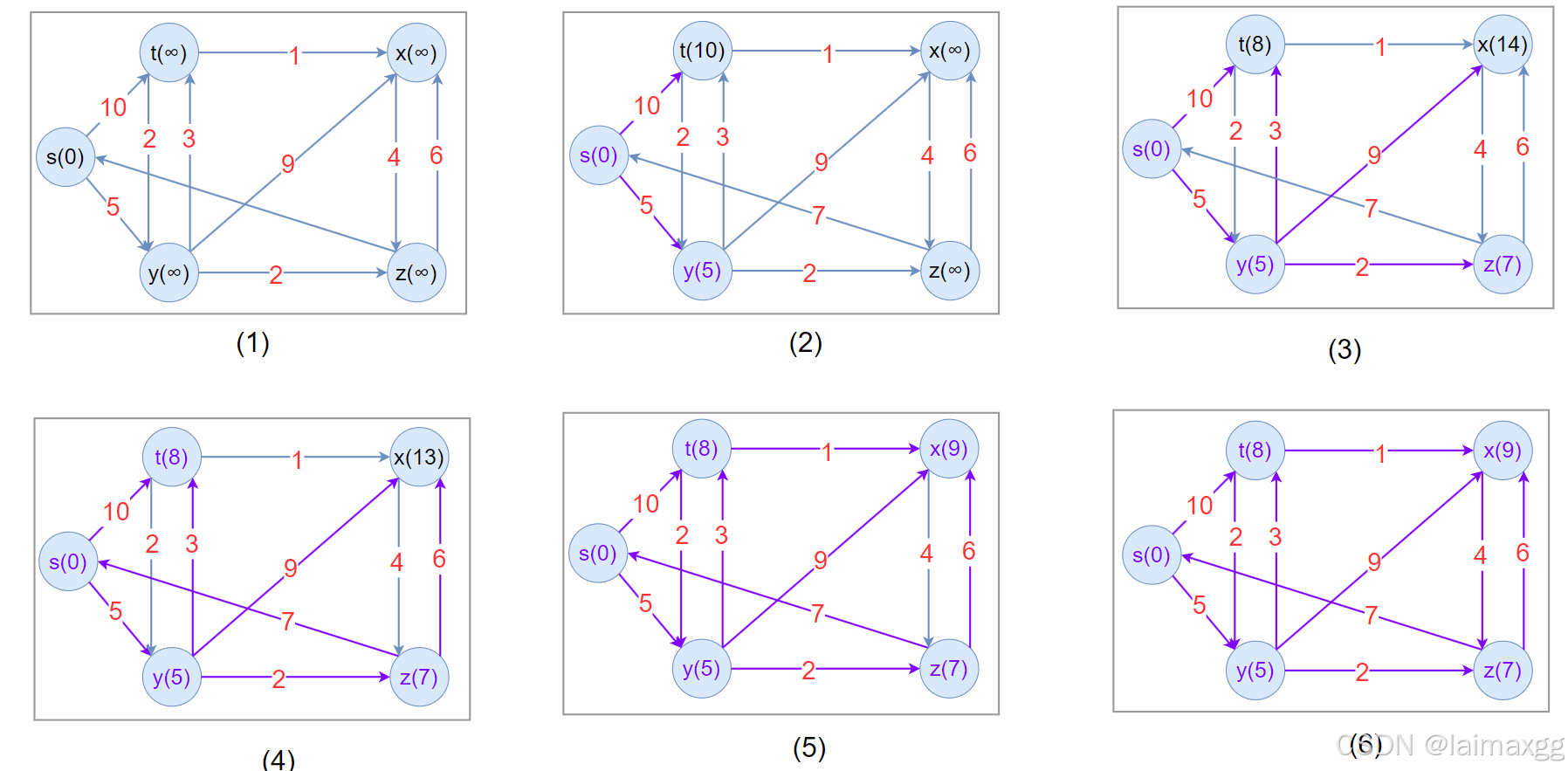
本图重绘《算法导论》中 Dijkstra 算法的算法流程。字体颜色为紫色的顶点为最短路径确定的顶点。
代码实现
vector<int> dist 保存从源顶点到各个顶点的最短路径长度,初始时所有顶点的距离设为无穷大;vector<int> parentPath 保存每个顶点在最短路径上的前驱顶点,初始时全部设为 -1;vector<bool> confirm 存储已确定最短路径的顶点;
//...
void Dijstra(const V& src)
{
vector<int> dist(_vertexs.size(), MAX_W);
vector<int> parentPath(_vertexs.size(), MAX_W);
size_t srci = GetVertexIndex(src);
vector<bool> confirm(_vertexs.size(), false);//存储已确定最短路径的顶点
dist[srci] = W();//源点的最短路径是最小值
for (size_t i = 0; i < _vertexs.size(); i++)
{
W min = MAX_W; //最短路径,初值为最大值
size_t u = srci;
//遍历当前顶点的最小的边,更新符合条件的最短路径
for (size_t j = 0; j < _vertexs.size(); j++)
{
if (confirm[j] == false && dist[j] < min)
{
min = dist[j];
u = j;
}
}
confirm[u] = true; //顶点u的最短路径确定
//遍历顶点 u 相邻的所有顶点,查找能够更新最短路径的顶点
for (size_t k = 0; k < _vertexs.size(); k++)
{
//如果顶点k没有确定最短路径,且u和k相邻,且此时从源点到u的距离加上u到k的距离小于此时k的最短路径
if (confirm[k] == false && _matrix[u][k] != MAX_W && dist[u] + _matrix[u][k]<dist[k])
{
cout << _vertexs[k] << "的最短路径由 " << dist[k] << " 更新为 " << dist[u] + _matrix[u][k] << endl;
dist[k] = dist[u] + _matrix[u][k];
parentPath[k] = u;
}
}
}
}
//...
int main()
{
const char* str = "syztx";
Graph<char, int,INT_MAX, true> g(str, strlen(str));
g.AddEdge('s', 't', 10);
g.AddEdge('s', 'y', 5);
g.AddEdge('y', 't', 3);
g.AddEdge('y', 'x', 9);
g.AddEdge('y', 'z', 2);
g.AddEdge('z', 's', 7);
g.AddEdge('z', 'x', 6);
g.AddEdge('t', 'y', 2);
g.AddEdge('t', 'x', 1);
g.AddEdge('x', 'z', 4);
g.Dijstra('s');
}

4.2.2 Bellman-Ford算法
Bellman-Ford 算法可以用于解决负权图的单源最短路径问题,而且可以用来判断是否有负权回路。
注意,无论哪种最短路径算法,负权回路都是无法求出最短路径的。负权回路会导致最短路径无法定义(因为可以无限变短)。Dijkstra 算法可能得出错误结果,而 Bellman-Ford 算法能够正确检测到负权回路,但不会返回最短路径。
算法过程:
- 确定源顶点 src,将其他顶点到 src 的距离初值设置为 ∞ \infty ∞。
- 对所有边 ( u , v , w ) (u,v,w) (u,v,w) 进行松弛(即更新 d [ v ] d[v] d[v]):如果 d [ u ] + w < d [ v ] d[u]+w<d[v] d[u]+w<d[v] ,则更新 d [ v ] = d [ u ] + w d[v]=d[u]+w d[v]=d[u]+w。
- 重复 2 N − 1 N-1 N−1 次(N 为顶点的个数),或重复直到不能更新最短路径。
- 再次遍历所有边,判断有无负权回路。

本图重绘《算法导论》中 Bellman-Ford 算法的算法流程。紫色的边为进行最短路径更新时所选的边,图 (5) 中更新的是 -4 这条边。
4.2.2.1 代码实现
Bellman-Ford 算法的一个问题是,在更新顶点的最短路径的过程中,所有顶点的最短路径都不是确定的,有可能后更新的顶点,影响了早先更新顶点的最短路径,导致所有最短路径都要更新一次,Bellman-Ford 算法的主要问题就是在什么时候停止更新,这里我们选择使用一个 bool exchange 变量来判断是否发生更新,避免每次都要遍历 N-1 次(N 为顶点的个数)才能求出最短路径。
//...
bool BellmanFord(const V& src)
{
vector<int> dist(_vertexs.size(), MAX_W);
vector<int> parentPath(_vertexs.size(), MAX_W);
size_t srci = GetVertexIndex(src);
dist[srci] = W(); //源点的最短路径为最小值
for (size_t k = 0; k < _vertexs.size() - 1; k++)
{
bool exchange = false;//用于判断是否有最短路径发生更新
for (size_t i = 0; i < _vertexs.size(); i++)
{
for (size_t j = 0; j < _vertexs.size(); j++)
{
if (_matrix[i][j] != MAX_W && dist[i] + _matrix[i][j] < dist[j])
{
cout << _vertexs[j] << "的最短路径由 " << dist[j] << " 更新为 " << dist[i] + _matrix[i][j] << endl;
//源点到i+i到j<源点到j,就更新最短路径
dist[j] = dist[i] + _matrix[i][j];
parentPath[j] = i;
exchange = true;
}
}
}
if (exchange == false)
{
break;
}
}
for (size_t i = 0; i < _vertexs.size(); i++)
{
for (size_t j = 0; j < _vertexs.size(); j++)
{
//检查是否有负权回路
if (_matrix[i][j] != MAX_W && dist[i] + _matrix[i][j] < dist[j])
{
//最短路径求完,但有从源点到i+i到j<从源点到j,说明存在负权回路
return false;
}
}
}
return true;
}
//...
int main()
{
const char* str = "syztx";
Graph<char, int, INT_MAX, true> g(str, strlen(str));
g.AddEdge('s', 't', 6);
g.AddEdge('s', 'y', 7);
g.AddEdge('y', 'z', 9);
g.AddEdge('y', 'x', -3);
g.AddEdge('z', 's', 2);
g.AddEdge('z', 'x', 7);
g.AddEdge('t', 'y', 8);
g.AddEdge('t', 'x', 5);
g.AddEdge('t', 'z', -4);
g.AddEdge('x', 't', -2);
g.BellmanFord('s');
}

4.2.3 Floyd-Warshall算法
Floyd-Warshall 算法从功能上看,与 Dijkstra 算法和 Bellman-Ford 算法的不同是,Floyd-Warshall 算法计算的是多源最短路径,即它能够计算任意两个顶点的最短路径。Floyd-Warshall 算法的关键是思想是通过中间顶点去更新最短路径。
算法过程:
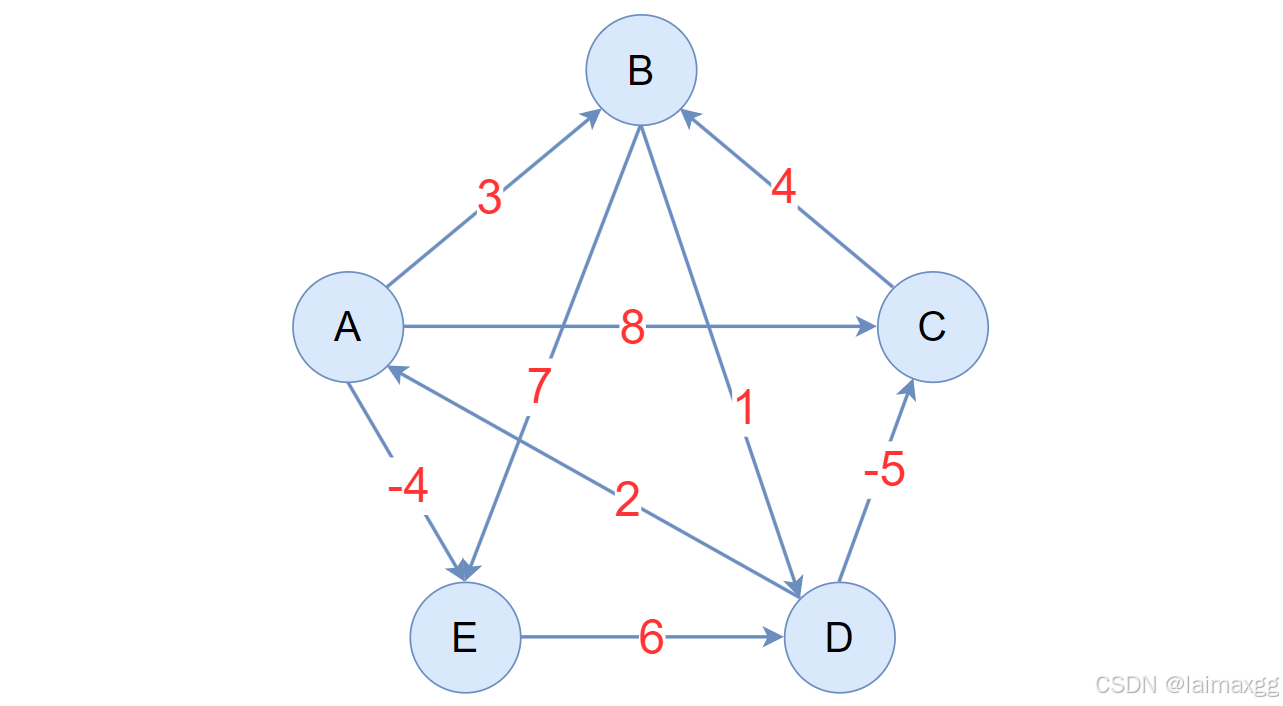
本图重绘《算法导论》中 Floyd-Warshall 算法的算法流程。为了方便理解,将顶点的值由数字改成了字母。
{ 0 , 1 , 2 , 3 , 4 , 5 } \{0,1,2,3,4,5\} {0,1,2,3,4,5} 分别表示 { 开始 , A , B , C , D } \{开始,A,B,C,D\} {开始,A,B,C,D}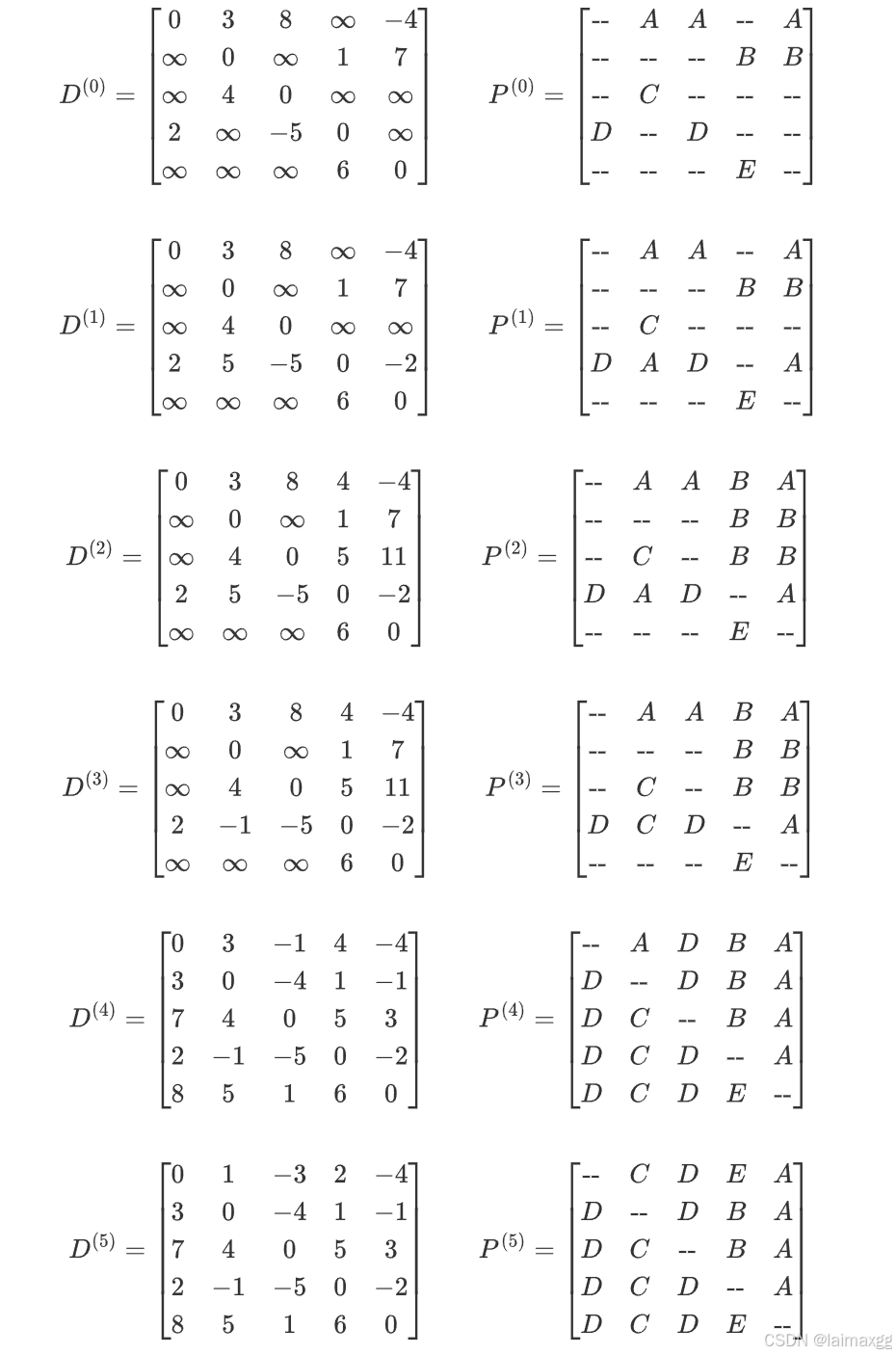
最终, D ( 5 ) D^{(5)} D(5) 中的内容就是邻接矩阵内任意两个顶点的最短路径。
说明:
左边的 D D D 矩阵为邻接矩阵, D n D^n Dn 的 n n n 表示该矩阵的中间顶点。整个矩阵表示当前求得的对应两顶点,经过顶点 n n n 的最短路径。在更新最短路径的过程中,,如果经过顶点 n n n 的两顶点的最短路径更短,就在矩阵上更新,否则最短路径的值与前一个矩阵相同。
右边的矩阵 P P P 为,对于任意顶点对 ( i , j ) (i, j) (i,j),若存在一条最短路径,则 P [ i ] [ j ] P[i][j] P[i][j] 表示从 i i i 到 j 的路径中 j j j 的“前一个顶点”(即 j j j 的直接前驱);如果 i i i 到 j j j 没有路径或 j j j 就是 i i i,则记作“ – – – ”或空。
动态的Floyd-Warshall 算法过程可以参考 B 站上的这个视频→ 图-最短路径-Floyd(弗洛伊德)
4.2.3.1 代码实现
代码中的 std::showpos 用于让正数的 + 显示出来,是为了让矩阵打印出来更整齐而使用的。
#include <vector>
#include <map>
#include <iostream>
#include <queue>
#include <iomanip>
//...
void FloydWarshall()
{
vector<vector<W>> vvDist(_vertexs.size(), vector<int>(_vertexs.size(), MAX_W));
vector<vector<int>> vvParentPath(_vertexs.size(), vector<int>(_vertexs.size(), 0));
for (size_t i = 0; i < _vertexs.size(); i++)
{
for (size_t j = 0; j < _vertexs.size(); j++)
{
if (_matrix[i][j] != MAX_W)
{
//初始化D(0)和P(0)矩阵的内容
vvDist[i][j] = _matrix[i][j];
vvParentPath[i][j] = i;
}
//这里用-1表示P矩阵中i到j没有路径或j就是i的情况
else
{
//i到j没有路径
vvParentPath[i][j] = -1;
}
if (i == j)
{
//j就是i
vvDist[i][j] = 0;
vvParentPath[i][j] = -1;
}
}
}
//打印矩阵变化过程
std::cout << std::showpos;
cout << "D(0):" << " " << "P(0):" << endl;
for (size_t i = 0; i < _vertexs.size(); i++)
{
for (size_t j = 0; j < _vertexs.size(); j++)
{
if (vvDist[i][j] == MAX_W)
{
cout<<" * ";
}
else
{
cout << vvDist[i][j] << " ";
}
}
cout << " ";
for (size_t j = 0; j < _vertexs.size(); j++)
{
cout << vvParentPath[i][j] << " ";
}
cout << endl;
}
int n = 1;
//k表示中间顶点
for (size_t k = 0; k < _vertexs.size(); k++)
{
for (size_t i = 0; i < _vertexs.size(); i++)
{
for (size_t j = 0; j < _vertexs.size(); j++)
{
if (vvDist[i][k] != MAX_W && vvDist[k][j]!=MAX_W && vvDist[i][k] + vvDist[k][j] < vvDist[i][j])
{
//如果从i经过k到j的路径比当前从i到j的最短路径更短,就更新最短路径
vvDist[i][j] = vvDist[i][k] + vvDist[k][j];
vvParentPath[i][j] = vvParentPath[k][j];
}
}
}
//打印矩阵变化过程
cout << "====================================================" << endl;
cout << "D(" << n << "):" << " " << "P(" << n << "):" << endl;
for (size_t i = 0; i < _vertexs.size(); i++)
{
for (size_t j = 0; j < _vertexs.size(); j++)
{
if (vvDist[i][j] == MAX_W)
{
cout << " * ";
}
else
{
cout << vvDist[i][j] << " ";
}
}
cout << " ";
for (size_t j = 0; j < _vertexs.size(); j++)
{
cout << vvParentPath[i][j] << " ";
}
cout << endl;
}
n++;
}
}
//...
int main()
{
string a[] = { "A", "B", "C", "D" ,"E" };
Graph<string, int, INT_MAX, true> g1(a, 5);
g1.AddEdge("A", "B", 3);
g1.AddEdge("A", "E", -4);
g1.AddEdge("A", "C", 8);
g1.AddEdge("B", "E", 7);
g1.AddEdge("B", "D", 1);
g1.AddEdge("C", "B", 4);
g1.AddEdge("D", "C", -5);
g1.AddEdge("D", "A", 2);
g1.AddEdge("E", "D", 6);
g1.FloydWarshall();
}
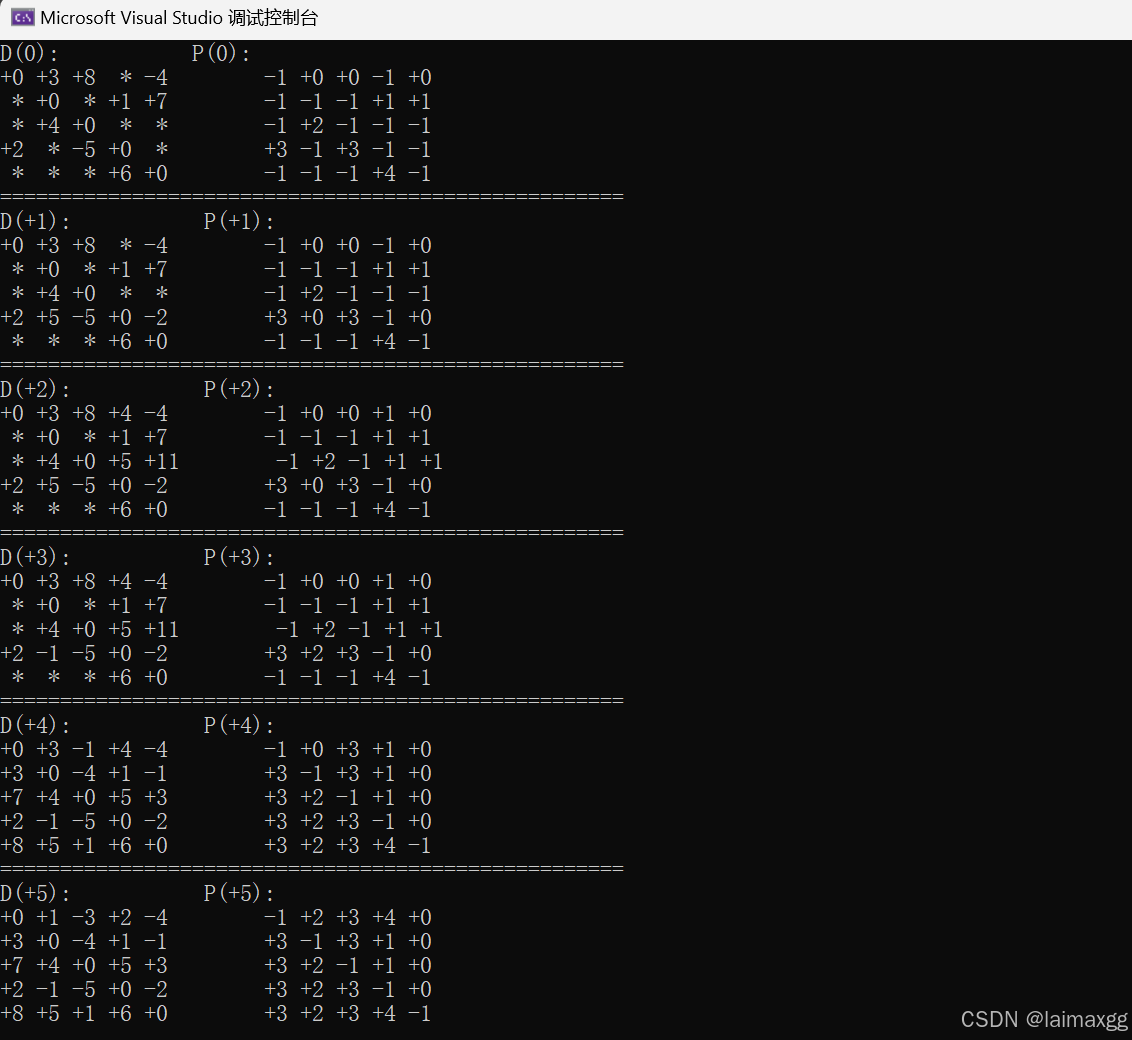
P 矩阵中的内容为下标, { 0 , 1 , 2 , 3 , 4 } \{0,1,2,3,4\} {0,1,2,3,4} 分别表示 { A , B , C , D } \{A,B,C,D\} {A,B,C,D} , − 1 -1 −1 表示空或前驱顶点为本身。
5. 完整代码
5.1 邻接矩阵
邻接矩阵的代码包括图的遍历和所有图的算法。
#include <vector>
#include <map>
#include <iostream>
#include <queue>
#include <iomanip>
using namespace std;
class UnionFindSet
{
public:
UnionFindSet(size_t size) :_ufs(size, -1) {}
int FindRoot(int index)
{
if (_ufs[index] < 0)
{
return index;
}
return _ufs[index] = FindRoot(_ufs[index]);
}
bool Union(int x, int y)
{
int root1 = FindRoot(x);
int root2 = FindRoot(y);
//如果两个元素本就在同一个集合返回false
if (root1 == root2)
{
return false;
}
//按秩合并,将较矮的树合并到较高的树下
//由于用负数表示秩,值越小树的高度越高
if (_ufs[root1] > _ufs[root2])
swap(root1, root2);
// 将集合 root2 合并到 root1 上
_ufs[root1] += _ufs[root2];
_ufs[root2] = root1;
return true;
}
int Count()
{
int count = 0;
for (auto it : _ufs)
{
if (it < 0)
{
count++;
}
}
return count;
}
bool InSet(int x, int y)
{
return FindRoot(x) == FindRoot(y);
}
private:
vector<int> _ufs;
};
//邻接矩阵
template<class V,class W,W MAX_W = INT_MAX, bool Direction = false>
class Graph
{
public:
typedef Graph<V, W, MAX_W, Direction> Self;
Graph() = default;
Graph(const V* vertexs, size_t n)
{
_vertexs.reserve(n);
for (size_t i = 0; i < n; i++)
{
_vertexs.push_back(vertexs[i]);
_vIndexMap[vertexs[i]] = i;
}
//用MAX_W表示无穷大
_matrix.resize(n, vector<W>(n, MAX_W));
}
size_t GetVertexIndex(const V& v)
{
auto ret = _vIndexMap.find(v);
if (ret != _vIndexMap.end())
{
return ret->second;
}
else
{
throw invalid_argument("不存在的顶点");
return -1;
}
}
void AddEdge(const V& src, const V& dest, const W& w)
{
size_t srci = GetVertexIndex(src);
size_t desti = GetVertexIndex(dest);
_matrix[srci][desti] = w;
if (Direction == false)
{
_matrix[desti][srci] = w;
}
}
void PrintMatrix() const
{
cout << "邻接矩阵:" << endl;
for (const auto& row : _matrix)
{
for (const auto& weight : row)
{
if (weight == MAX_W)
cout << "∞\t"; // 用 "∞" 表示无穷大
else
cout << weight << "\t";
}
cout << endl;
}
}
void BFS(const V& src)
{
size_t srcindex = GetVertexIndex(src);
vector<bool> isvisted(_vertexs.size(), false); //存储顶点是否已经被遍历过
queue<int> q;
q.push(srcindex);
isvisted[srcindex] = true;
size_t d = 1;
size_t dsize = 1;
while (!q.empty())
{
dsize = q.size();
cout << "Level"<<d<<": ";
while (dsize--)
{
size_t front = q.front();
q.pop();
for (size_t i = 0; i < _vertexs.size(); i++)
{
if (isvisted[i] == false && _matrix[front][i] != MAX_W)
{
cout<< "["<<_vertexs[i] << ":" << _matrix[front][i]<<"]";
isvisted[i] = true;
q.push(i);
}
}
}
cout << endl;
d++;
}
}
void _DFS(const V& v, vector<bool>& isvisted)
{
cout << v << " ";
int index = GetVertexIndex(v);
for (int i = 0; i < _vertexs.size(); i++)
{
if (_matrix[index][i]!= MAX_W && !isvisted[i])
{
isvisted[i] = true;
_DFS(_vertexs[i],isvisted);
}
}
}
void DFS(const V& v)
{
vector<bool> isvisted(_vertexs.size(), false); //存储顶点是否已经被遍历过
int index = GetVertexIndex(v);
isvisted[index] = true;
_DFS(v, isvisted);
}
struct Edge
{
size_t _srci;
size_t _desti;
W _w;
Edge(size_t srci,size_t desti,const W& w):_srci(srci),_desti(desti),_w(w){}
bool operator>(const Edge& e) const
{
return _w > e._w;
}
};
W Kruskal(Self& minTree)
{
minTree._vertexs = _vertexs;
minTree._vIndexMap = _vIndexMap;
minTree._matrix.resize(_vertexs.size());
for (auto& it : minTree._matrix)
{
it.resize(_vertexs.size(), MAX_W);
}
priority_queue<Edge, vector<Edge>, greater<Edge>> minque;
for (size_t i = 0; i < _vertexs.size(); i++)
{
for (size_t j = 0; j < _vertexs.size(); j++)
{
if (i < j && _matrix[i][j] != MAX_W)
{
minque.push(Edge(i, j, _matrix[i][j]));//minque的第一个元素总是权值最小的边
}
}
}
int size = 0;
W totalW = W();
UnionFindSet ufs(_vertexs.size());
while (!minque.empty())
{
Edge min = minque.top();
minque.pop();
if (!ufs.InSet(min._srci, min._desti))
{
minTree.AddEdge(_vertexs[min._srci], _vertexs[min._desti], min._w);
cout << _vertexs[min._srci] << "-" << min._w << ">" << _vertexs[min._desti] << endl;
ufs.Union(min._srci, min._desti);
size++;
totalW += min._w;
}
}
if (size == _vertexs.size() - 1)
{
//如果能够构建最小生成树
return totalW;
}
else
{
return W();
}
}
W Prim(Self& minTree,const V& src)
{
minTree._vertexs = _vertexs;
minTree._vIndexMap = _vIndexMap;
minTree._matrix.resize(_vertexs.size());
for (auto& it : minTree._matrix)
{
it.resize(_vertexs.size(), MAX_W);
}
size_t srci = GetVertexIndex(src);
//用X存储在生成树中的顶点,用Y存储不在生成树中的顶点
vector<bool> inTree(_vertexs.size(), false);
inTree[srci] = true;
priority_queue<Edge, vector<Edge>, greater<Edge>> minque;
for (size_t i = 0; i < _vertexs.size(); i++)
{
if (_matrix[srci][i] != MAX_W)
{
minque.push(Edge(srci, i, _matrix[srci][i]));//先将根节点所有的边放入优先队列中
}
}
size_t size = 0;
W totalW = W();
while (!minque.empty())
{
Edge min = minque.top();
minque.pop();
//如果最小边在X里,连接会构成环
if (inTree[min._desti])
{
continue;
}
else
{
minTree.AddEdge(_vertexs[min._srci], _vertexs[min._desti], min._w);
cout << _vertexs[min._srci] << "-" << min._w << ">" << _vertexs[min._desti] << endl;
inTree[min._desti] = true;
size++;
totalW += min._w;
if (size == _vertexs.size() - 1)
{
//如果最小生成树构建完,退出循环
break;
}
for (size_t i = 0; i < _vertexs.size(); i++)
{
if (_matrix[min._desti][i] != MAX_W && !inTree[i])
{
//将新连接的顶点放入最小生成树中
minque.push(Edge(min._desti, i, _matrix[min._desti][i]));
}
}
}
}
if (size == _vertexs.size() - 1)
{
return totalW;
}
else
{
return W();
}
}
void Dijstra(const V& src)
{
vector<int> dist(_vertexs.size(), MAX_W);
vector<int> parentPath(_vertexs.size(), MAX_W);
size_t srci = GetVertexIndex(src);
vector<bool> confirm(_vertexs.size(), false);//存储已确定最短路径的顶点
dist[srci] = W();//源点的最短路径是最小值
for (size_t i = 0; i < _vertexs.size(); i++)
{
W min = MAX_W; //最短路径,初值为最大值
size_t u = srci;
//遍历当前顶点的最小的边,更新符合条件的最短路径
for (size_t j = 0; j < _vertexs.size(); j++)
{
if (confirm[j] == false && dist[j] < min)
{
min = dist[j];
u = j;
}
}
confirm[u] = true; //顶点u的最短路径确定
//遍历顶点 u 相邻的所有顶点,查找能够更新最短路径的顶点
for (size_t k = 0; k < _vertexs.size(); k++)
{
//如果顶点k没有确定最短路径,且u和k相邻,且此时从源点到u的距离加上u到k的距离小于此时k的最短路径
if (confirm[k] == false && _matrix[u][k] != MAX_W && dist[u] + _matrix[u][k]<dist[k])
{
cout << _vertexs[k] << "的最短路径由 " << dist[k] << " 更新为 " << dist[u] + _matrix[u][k] << endl;
dist[k] = dist[u] + _matrix[u][k];
parentPath[k] = u;
}
}
}
}
bool BellmanFord(const V& src)
{
vector<int> dist(_vertexs.size(), MAX_W);
vector<int> parentPath(_vertexs.size(), MAX_W);
size_t srci = GetVertexIndex(src);
dist[srci] = W(); //源点的最短路径为最小值
for (size_t k = 0; k < _vertexs.size() - 1; k++)
{
bool exchange = false;//用于判断是否有最短路径发生更新
for (size_t i = 0; i < _vertexs.size(); i++)
{
for (size_t j = 0; j < _vertexs.size(); j++)
{
if (_matrix[i][j] != MAX_W && dist[i] + _matrix[i][j] < dist[j])
{
cout << _vertexs[j] << "的最短路径由 " << dist[j] << " 更新为 " << dist[i] + _matrix[i][j] << endl;
//源点到i+i到j<源点到j,就更新最短路径
dist[j] = dist[i] + _matrix[i][j];
parentPath[j] = i;
exchange = true;
}
}
}
if (exchange == false)
{
break;
}
}
for (size_t i = 0; i < _vertexs.size(); i++)
{
for (size_t j = 0; j < _vertexs.size(); j++)
{
//检查是否有负权回路
if (_matrix[i][j] != MAX_W && dist[i] + _matrix[i][j] < dist[j])
{
//最短路径求完,但有从源点到i+i到j<从源点到j,说明存在负权回路
return false;
}
}
}
return true;
}
void FloydWarshall()
{
vector<vector<W>> vvDist(_vertexs.size(), vector<int>(_vertexs.size(), MAX_W));
vector<vector<int>> vvParentPath(_vertexs.size(), vector<int>(_vertexs.size(), 0));
for (size_t i = 0; i < _vertexs.size(); i++)
{
for (size_t j = 0; j < _vertexs.size(); j++)
{
if (_matrix[i][j] != MAX_W)
{
//初始化D(0)和P(0)矩阵的内容
vvDist[i][j] = _matrix[i][j];
vvParentPath[i][j] = i;
}
//这里用-1表示P矩阵中i到j没有路径或j就是i的情况
else
{
//i到j没有路径
vvParentPath[i][j] = -1;
}
if (i == j)
{
//j就是i
vvDist[i][j] = 0;
vvParentPath[i][j] = -1;
}
}
}
//打印矩阵变化过程
std::cout << std::showpos;
cout << "D(0):" << " " << "P(0):" << endl;
for (size_t i = 0; i < _vertexs.size(); i++)
{
for (size_t j = 0; j < _vertexs.size(); j++)
{
if (vvDist[i][j] == MAX_W)
{
cout<<" * ";
}
else
{
cout << vvDist[i][j] << " ";
}
}
cout << " ";
for (size_t j = 0; j < _vertexs.size(); j++)
{
cout << vvParentPath[i][j] << " ";
}
cout << endl;
}
int n = 1;
//k表示中间顶点
for (size_t k = 0; k < _vertexs.size(); k++)
{
for (size_t i = 0; i < _vertexs.size(); i++)
{
for (size_t j = 0; j < _vertexs.size(); j++)
{
if (vvDist[i][k] != MAX_W && vvDist[k][j]!=MAX_W && vvDist[i][k] + vvDist[k][j] < vvDist[i][j])
{
//如果从i经过k到j的路径比当前从i到j的最短路径更短,就更新最短路径
vvDist[i][j] = vvDist[i][k] + vvDist[k][j];
vvParentPath[i][j] = vvParentPath[k][j];
}
}
}
//打印矩阵变化过程
cout << "====================================================" << endl;
cout << "D(" << n << "):" << " " << "P(" << n << "):" << endl;
for (size_t i = 0; i < _vertexs.size(); i++)
{
for (size_t j = 0; j < _vertexs.size(); j++)
{
if (vvDist[i][j] == MAX_W)
{
cout << " * ";
}
else
{
cout << vvDist[i][j] << " ";
}
}
cout << " ";
for (size_t j = 0; j < _vertexs.size(); j++)
{
cout << vvParentPath[i][j] << " ";
}
cout << endl;
}
n++;
}
}
private:
map<V, size_t> _vIndexMap;//快速查找顶点在邻接矩阵中的索引
vector<V> _vertexs; //顶点集合
vector<vector<W>> _matrix; //边的邻接矩阵
};
5.2 邻接表
邻接表的代码没有最短路径的代码。
#include <vector>
#include <map>
#include <iostream>
#include <string>
#include <queue>
using namespace std;
//邻接表
template<class W>
class LinkEdge
{
public:
int _srcIndex;
int _destIndex;
W _w;
LinkEdge<W>* _next;
LinkEdge(const W& w):_srcIndex(-1),_destIndex(-1),_w(w),_next(nullptr)
{}
};
template<class V, class W, bool Direction = false>
class Graph
{
public:
typedef LinkEdge<W> Edge;
Graph(const V* vertex,size_t n)
{
for (size_t i = 0; i < n; i++)
{
_vertexs.push_back(vertex[i]);
_vIndexMap[vertex[i]] = i;
}
_tables.resize(n, nullptr);
}
size_t GetVertexIndex(const V& v)
{
auto ret = _vIndexMap.find(v);
if (ret != _vIndexMap.end())
{
return ret->second;
}
else
{
throw invalid_argument("不存在的顶点");
return -1;
}
}
void AddEdge(const V& src, const V& dest, const W& w)
{
size_t srcIndex = GetVertexIndex(src);
size_t destIndex = GetVertexIndex(dest);
Edge* edge = new Edge(w);
edge->_srcIndex = srcIndex;
edge->_destIndex = destIndex;
//头插
edge->_next = _tables[srcIndex];
_tables[srcIndex] = edge;
if (Direction == false)
{
Edge* dest_edge = new Edge(w);
dest_edge->_srcIndex = destIndex;
dest_edge->_destIndex = srcIndex;
dest_edge->_next = _tables[destIndex];
_tables[destIndex] = dest_edge;
}
}
void PrintGraph() const
{
for (size_t i = 0; i < _tables.size(); i++)
{
cout << _vertexs[i] << " -> ";
Edge* p = _tables[i];
while (p != nullptr)
{
cout << "[" << _vertexs[p->_destIndex] << ", " << p->_w << "] ";
p = p->_next;
}
cout << endl;
}
}
void _DFS(int index, vector<bool>& isvisted)
{
isvisted[index] = true;
cout << _vertexs[index] << " ";
Edge* edge = _tables[index];
while (edge)
{
if (!isvisted[edge->_destIndex])
{
_DFS(edge->_destIndex, isvisted);
}
edge = edge->_next;
}
}
void DFS(const V& v)
{
vector<bool> isvisted(_vertexs.size(), false);
int index = GetVertexIndex(v);
_DFS(index, isvisted);
}
void BFS(const V& v)
{
vector<bool> isvisted(_vertexs.size(), false); //存储顶点是否已经被遍历过
queue<int> q;
int index = GetVertexIndex(v);
q.push(index);
isvisted[index] = true;
while (!q.empty())
{
int currentIndex = q.front();
q.pop();
cout << _vertexs[currentIndex] << " ";
Edge* edge = _tables[currentIndex];
while (edge)
{
if (!isvisted[edge->_destIndex])
{
q.push(edge->_destIndex);
isvisted[edge->_destIndex] = true;
}
edge = edge->_next;
}
}
}
private:
map<string, int> _vIndexMap;//快速查找顶点在邻接矩阵中的索引
vector<V> _vertexs; //顶点集合
vector<Edge*> _tables; //邻接表
};
5.3 测试用例
void TestBFS_and_DFS()
{
string a[] = { "A", "B", "C", "D" ,"E","F","G","H" };
Graph<string, int> g1(a, 8);
g1.AddEdge("A", "B", 10);
g1.AddEdge("A", "F", 20);
g1.AddEdge("B", "C", 30);
g1.AddEdge("C", "D", 40);
g1.AddEdge("C", "E", 50);
g1.AddEdge("D", "E", 60);
g1.AddEdge("D", "G", 70);
g1.AddEdge("G", "H", 80);
g1.AddEdge("G", "F", 90);
//g1.BFS("A");
//g1.DFS("A");
}
void TestKruskal_and_Prim()
{
string a[] = { "a", "b", "c", "d" ,"e","f","g","h","i"};
Graph<string, int> g1(a, 9);
g1.AddEdge("a", "b", 4);
g1.AddEdge("b", "h", 11);
g1.AddEdge("a", "h", 8);
g1.AddEdge("b", "c", 8);
g1.AddEdge("c", "d", 7);
g1.AddEdge("c", "i", 2);
g1.AddEdge("d", "e", 9);
g1.AddEdge("d", "f", 14);
g1.AddEdge("e", "f", 10);
g1.AddEdge("f", "g", 2);
g1.AddEdge("f", "c", 4);
g1.AddEdge("g", "i", 6);
g1.AddEdge("g", "h", 1);
g1.AddEdge("h", "i", 7);
Graph<string, int> minTree;
g1.Kruskal(minTree);
//cout<< g1.Prim(minTree,"a");
//minTree.PrintMatrix();
}
void TestDijstra()
{
const char* str = "syztx";
Graph<char, int, INT_MAX, true> g(str, strlen(str));
g.AddEdge('s', 't', 10);
g.AddEdge('s', 'y', 5);
g.AddEdge('y', 't', 3);
g.AddEdge('y', 'x', 9);
g.AddEdge('y', 'z', 2);
g.AddEdge('z', 's', 7);
g.AddEdge('z', 'x', 6);
g.AddEdge('t', 'y', 2);
g.AddEdge('t', 'x', 1);
g.AddEdge('x', 'z', 4);
g.Dijstra('s');
}
void TestBellmanFord()
{
const char* str = "syztx";
Graph<char, int, INT_MAX, true> g(str, strlen(str));
g.AddEdge('s', 't', 6);
g.AddEdge('s', 'y', 7);
g.AddEdge('y', 'z', 9);
g.AddEdge('y', 'x', -3);
g.AddEdge('z', 's', 2);
g.AddEdge('z', 'x', 7);
g.AddEdge('t', 'y', 8);
g.AddEdge('t', 'x', 5);
g.AddEdge('t', 'z', -4);
g.AddEdge('x', 't', -2);
g.BellmanFord('s');
}
void TestFloydWarshall()
{
string a[] = { "A", "B", "C", "D" ,"E" };
Graph<string, int, INT_MAX, true> g1(a, 5);
g1.AddEdge("A", "B", 3);
g1.AddEdge("A", "E", -4);
g1.AddEdge("A", "C", 8);
g1.AddEdge("B", "E", 7);
g1.AddEdge("B", "D", 1);
g1.AddEdge("C", "B", 4);
g1.AddEdge("D", "C", -5);
g1.AddEdge("D", "A", 2);
g1.AddEdge("E", "D", 6);
g1.FloydWarshall();
}

DAMO开发者矩阵,由阿里巴巴达摩院和中国互联网协会联合发起,致力于探讨最前沿的技术趋势与应用成果,搭建高质量的交流与分享平台,推动技术创新与产业应用链接,围绕“人工智能与新型计算”构建开放共享的开发者生态。
更多推荐
 已为社区贡献1条内容
已为社区贡献1条内容








所有评论(0)